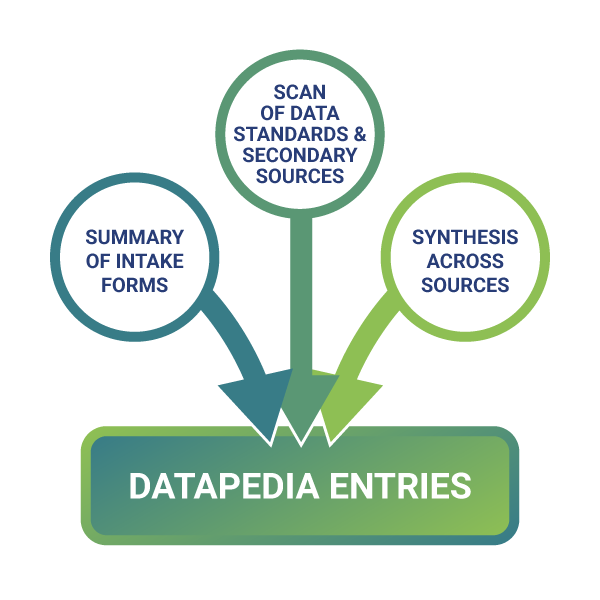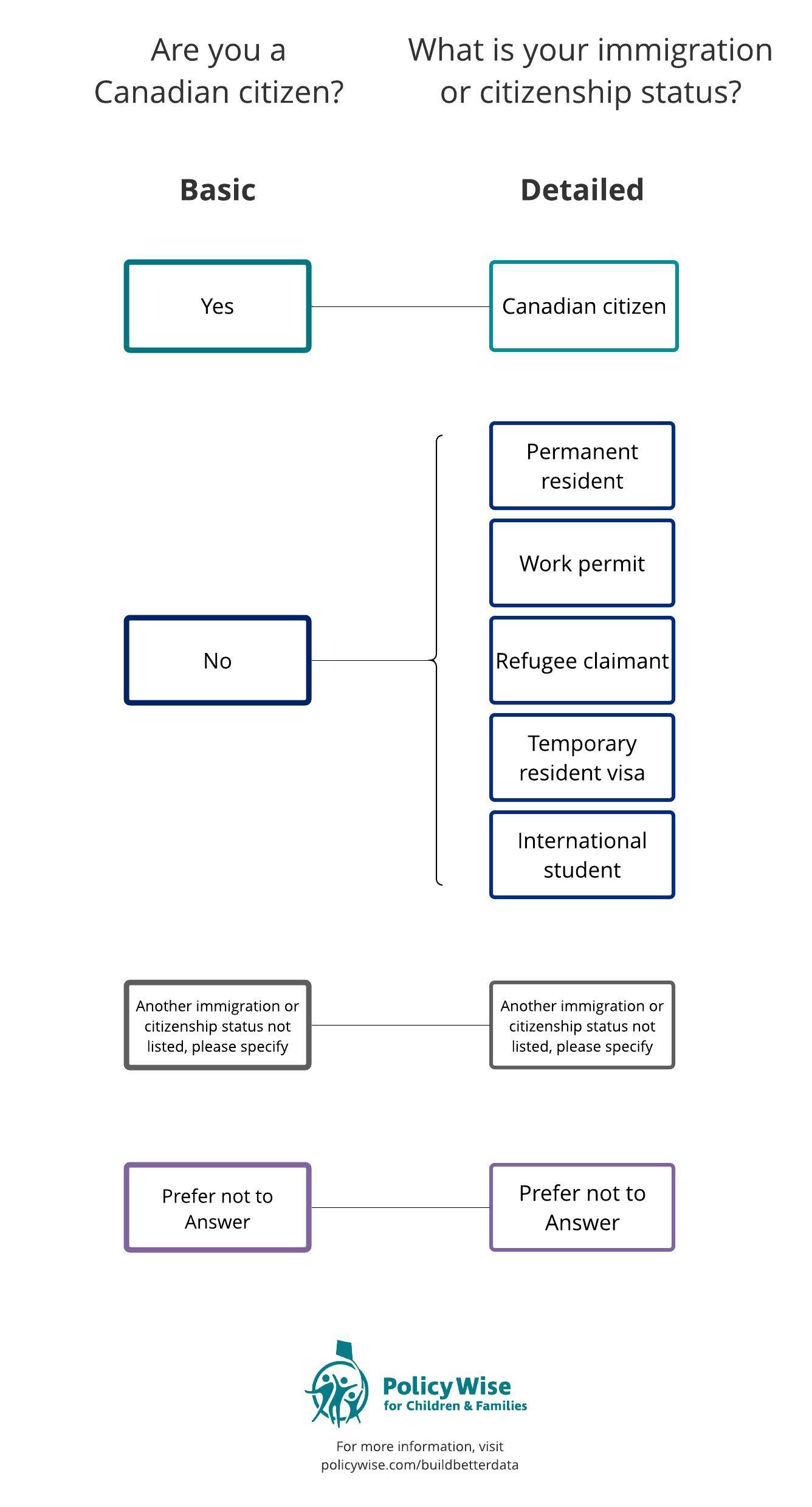Demographic Datapedia Entry:
Citizenship
Each Datapedia entry begins with definition(s) of the demographic variable followed by some considerations and limitations of the variable for understanding populations of people.
Next, a suggested question(s) and response options are shown. Note that this is given as guidance rather than a prescription of what’s best as that will depend on the information needs and context of your organization. Also included are ideas and examples of how to ask questions about the demographic variable in conversation.

Plan
It’s important to invest time in seeking out your “Why?” with data to ensure the data collected support your information needs. For more on this, see the Plan section of the Data Lifecycle.
Finally, a diagram is shown to illustrate basic, detailed, and comprehensive response options for the variable.
- The basic options are the minimum set of response options that are suggested for each variable.
- The detailed and comprehensive categories illustrate more detailed and nuanced response options that may be important to consider depending on your information needs and organization’s context.
- The diagram of response options show how each category can be collapsed into the basic set of answers. For example, the detailed and comprehensive response options can be collapsed or aggregated into the basic response options for analysis.
- Consider all response options when deciding on which category best suits your organization’s needs.
Importantly, the suggestions and details of the response options will need to be revisited and revised periodically to reflect shifts and changes that may emerge in various variables over time.1

BUILD
For ideas on how to collect and record quality data see the Build section of the Data Lifecycle.
2.1 Definition
A. Citizenship refers to the country that the individual has citizenship.2
B. Citizenship or immigration status refers to a person’s status according to the following Immigration, Refugees, and Citizenship Canada (IRCC) categories: permanent residents, convention refugees, Canadian citizens, refugee claimants, open work permits, closed work permits, student visas, and visitor.3, 4
2.2 Considerations and Limitations
Citizenship or immigration status can be used to understand:
- Requirements for eligibility of programs, employment, etc.5, 6
- Certain supports that are available to immigrants or refugees.7, 8, 9
- Eligibility for citizenship application.10
Citizenship and immigration status cannot be used to understand:
- Place of birth as that may differ from a person’s country of citizenship or residence.
- Citizenship journey.
- A person’s needs outside of immigration or refugee programs (e.g., employment or housing programs).7
- Whether a person is new to a country. Self-identification of newcomers may be of interest for program eligibility, reporting, or planning purposes. Whether a person is considered a “newcomer” depends on context 11, 12, 13, 14, 15 and there is no consensus about how many years a person is in Canada before they are no longer considered an “newcomer”.
- The indigeneity of a person. Indigenous peoples in Canada include First Nations (original inhabitants of what is now Canada), Métis (people of mixed European and Indigenous ancestry), and Inuit (Indigenous peoples who inhabit the northern regions of what is now Canada)16, 17, 18. Questions of indigeneity and Canadian citizenship are complex 19, 20 and currently, work is underway to “explore the relationship between traditional and Indian Act forms of governance systems as it relates specifically to citizenship.” 21 As well, please see the Datapedia entry on Indigenous peoples in Canada including First Nations, Métis, and Inuit.
Additional Considerations:
- Effective follow-up with newly landed clients after a certain time frame to allow for an adjustment period. 22
- Citizenship status does not reflect an individual’s employment and income levels. 23
- Culture may be an important consideration to ask about separately. 24
- Whether to ask at all? Is it relevant to the supports that agencies are providing to clients? 25
- If not a necessary question, ask follow-up questions or provide definitions for specific categories if clients do not understand. Sometimes there may be possible language barriers. 26
2.3 Suggested Collection Methods
The minimum suggested data collection method, or “basic” option below reflects a synthesis of practices, considerations from nonprofit stakeholders, and recognized standards in capturing demographic data. The “basic” question is modeled after what might be asked on an intake form during an initial meeting with a client. The process by which intake or registration occurs can vary widely depending on the context within which you are working. For example, the way questions are asked and data are recorded will vary for clients in crises, as compared to walk-in or drop-in sessions, or when
registering for a program that requires people to meet certain eligibility requirements. In those cases, the suggested collection method can be used as a starting point but adapted to fit the needs of the context within which the data are being collected.
As a standard practice we suggest always including an option for people to write in an answer that may not fit within the options provided, along with an option not to answer. These are both important for creating inclusive demographic questions.1, 27, 28
2.3.1 Basic Question(s)
1. Are you a Canadian citizen?
- Yes
- No
- Another immigration or citizenship status not listed, please specify: _____
- Prefer not to answer
In conversation, the question may be phrased as:
- Are you new to Canada?
- How long have you lived in Canada?
- Tell me about your life in Canada and how that started.
- Have you lived someplace else other than Canada?
2. What is your immigration or citizenship status?
- Canadian Citizen
- Permanent Resident
- Work Permit
- Refugee Claimant
- Temporary resident visa
- International student
- Another immigration or citizenship status not listed, please specify: _____
- Prefer not to answer
2.3.2 Diagram of Response Options
Are you a Canadian citizen?
What is your immigration or citizenship status?
The diagram shows an overview of the basic, detailed and comprehensive response options. The options are not necessarily exhaustive, but they are modeled after what organizations may want to provide depending on the needs and context of their work. The question can be found at the top of the diagram and the response choices are mapped into the basic, detailed, and comprehensive levels. Not all variables warrant all levels of response options.

COLLECT
For considerations on building trust and relationships through data collection see the Collect section of the Data Lifecycle.


LENSES
You may wish to approach your data collection work through the lens of a particular framework or set of guiding principles, which will shape how you think about your response options. For more details, see the Lenses section of the Data Lifecycle.
To create the diagram for variable responses, two main sets of sources were used.
- Organization intake and registration forms from nonprofit subsectors across Alberta.
- Best practices in data collection, academic literature of demographic data, and resources from data aggregators (e.g., Statistics Canada, National Institutes of Health).
Findings from these sources were synthesized and organized across three levels of response options: basic, detailed, and comprehensive. To learn more please see the full methods. Datapedia Project Approach and Acknowledgements.pdf
Footnotes
-
Frederick, J. K. (2020, November 18). Four strategies for crafting inclusive and effective demographic questions. Ithaka S+R Blog. https://sr.ithaka.org/blog/four-strategies-for-crafting-inclusive-and-effective-demographic-questions/
-
Statistics Canada. (2020, February 24). Citizenship of person. https://www23.statcan.gc.ca/imdb/p3Var.pl?Function=DEC&Id=85010.
-
Lu, Y. & Hou, F. (2019, November 18). Temporary foreign workers in the Canadian labour force: Open versus employer-specific work permits (No. 11-626-X). https://www150.statcan.gc.ca/n1/en/pub/11-626-x/11-626-x2019016-eng.pdf?st=cqHKd8_t
-
Statistics Canada. (2019, October 22). Immigrant status of person. www23.statcan.gc.ca/imdb/p3Var.pl?Function=DEC&Id=103339.
-
The Canadian Information Centre for International Credentials. (n.d.). Determine your eligibility to work in Canada. www.cicic.ca/939/determine_your_eligibility_to_work_in_canada.canada.
-
Immigration, Refugees and Citizenship Canada. (2019, September 27). Settlement program. www.canada.ca/en/immigration-refugees-citizenship/corporate/transparency/program-terms-conditions/settlement.html.
-
Immigration, Refugees and Citizenship Canada. (2020, January 30). What kind of support do government-assisted refugees get? www.cic.gc.ca/english/helpcentre/answer.asp?qnum=098&top=11.
-
Government of Alberta. (n.d.). Immigration settlement support programs. www.alberta.ca/immigration-settlement-support-programs.aspx.
-
Government of Canada. (2020, November 24). For new immigrants. www.canada.ca/en/immigration-refugees-citizenship/services/new-immigrants.html.
-
Government of Canada. (2020, October 1). Apply for citizenship: Who can apply. www.canada.ca/en/immigration-refugees-citizenship/services/canadian-citizenship/become-canadian-citizen/eligibility.html.
-
Statistics Canada. (11, February, 2010). Canada’s ethnocultural mosaic, 2006 Census: Definitions. https://www12.statcan.gc.ca/census-recensement/2006/as-sa/97-562/note-eng.cfm
-
Government of Canada. (18, January, 2021). https://www.canada.ca/en/revenue-agency/services/tax/international-non-residents/individuals-leaving-entering-canada-non-residents/newcomers-canada-immigrants.html
-
City of Toronto. (January, 2013). The Toronto newcomer strategy: Helping newcomers thrive and prosper.https://www.toronto.ca/city-government/accountability-operations-customer-service/long-term-vision-plans-and-strategies/toronto-newcomer-strategy/
-
Centre for Newcomers. (n.d). Settlement services for newcomers. https://www.centrefornewcomers.ca/settlement-services
-
Government of Alberta. (2014). Welcome to Alberta: Information for newcomers. https://alis.alberta.ca/media/2440/welcometoalberta.pdf
-
Assembly of First Nations. (n.d.) A declaration of First Nations. https://www.afn.ca/about-afn/declaration-of-first-nations/,
-
Métis Nation of Alberta.(n.d.) About. http://albertametis.com/about/,
-
Inuit Tapiriit Kanatami. (n.d.) About Canadian Inuit. https://www.itk.ca/about-canadian-inuit/
-
Federation of Saskatchewan Indian Nations. (March 8). First Nation citizenship. https://www.afn.ca/uploads/files/policy_forum/fsin_first_nation_citizenship_presentation_march_8.pdf
-
Northern Public Affairs. (7, October, 2015). Aboriginal citizenship in the 21st century. http://www.northernpublicaffairs.ca/index/from-the-magazine-aboriginal-citizenship-in-the-21st-century/
-
Ryerson University Chair in Indigenous Governance. (n.d.) Indigenous identity and citizenship. https://www.ryerson.ca/chair-indigenous-governance/research-projects/ongoing/indigenous-identity-citizenship/
-
Government of Canada. (2020, November 30). Find free newcomer services near you. www.cic.gc.ca/english/newcomers/services/index.asp.
-
Statistics Canada. (2019, March 12). Immigrant income by admission year and immigrant admission category, Canada and provinces. www150.statcan.gc.ca/t1/tbl1/en/tv.action?pid=4310001001.
-
Mayhew, M. (2018, April). Adaptation and acculturation. Caring for Kids New to Canada. www.kidsnewtocanada.ca/culture/adaptation.
-
Sidhu, N. (2013, August). Accessing community programs and services for non-status immigrants in Toronto: Organizational challenges and responses. Social Planning Toronto. https://www.socialplanningtoronto.org/accessing_community_programs_and_services_for_non_status_immigrants_in_toronto_organizational_challenges_and_responses
-
Bowen, S. (2006, March 31). Language barriers in access to health care (No. H39-578/2001E). www.canada.ca/en/health-canada/services/health-care-system/reports-publications/health-care-accessibility/language-barriers.html.
-
Fernandez, T., Godwin, A., Doyle, J., Verdin, D., Boone, H., Kirn, A., Benson, L., & Potvin, G., (2016). More Comprehensive and Inclusive Approaches to Demographic Data Collection. School of Engineering Education Graduate Student Series, 60. http://docs.lib.purdue.edu/enegs/60
-
Lesbian, Gay, Bisexual, & Transgender Equity Center. (n. d.). Good practices: Demographic data collection. University of Maryland. https://lgbt.umd.edu/good-practices-demographic-data-collection
Do you have additions to suggest to the Datapedia? Or, do you want to learn more about working with data?
We’d love to hear from you. Contact us at info@policywise.com.



